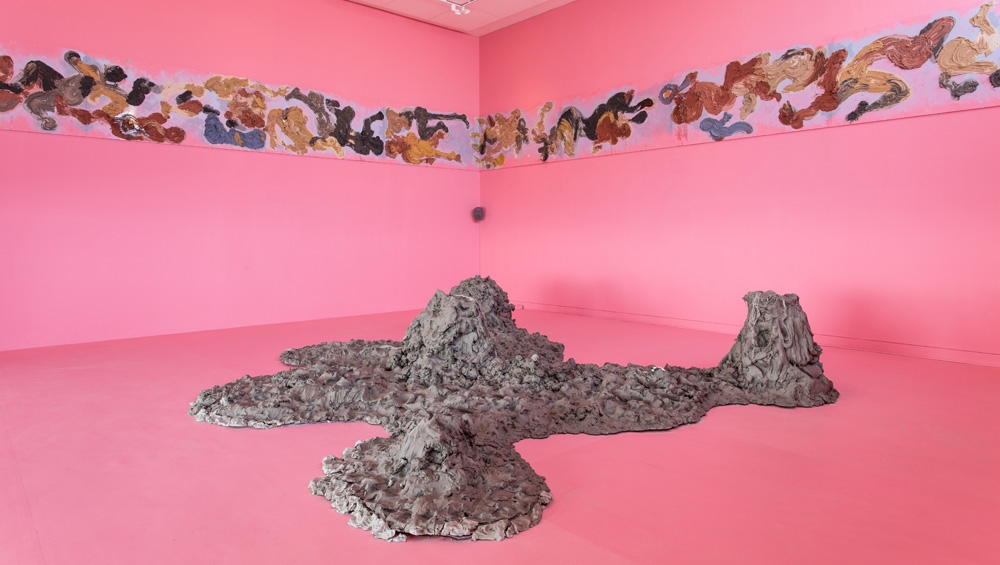
Florence Peake. RITE: On this pliant body we slip our WOW! 2018. Photograph: Rob Harris. Image courtesy De La Warr Pavilion.
by HATTY NESTOR
Situated in Bexhill, East Sussex, the De La Warr Pavilion embodies an aura of calm, tranquillity and mystery. Its setting on the town’s marina has a significant bearing on the gallery-goer’s viewing experience. Gazing out of the rear window to the English Channel, one has a profound sense of expansiveness, possibility and openness that is often lacking in more enclosed, city-based institutions and galleries. Opened in 1935 and named after the ninth Earl De La Warr, who was the driving force behind its creation, the pavilion was designed by Erich Mendelsohn and Serge Chermayeff. Its rich history and location make for an unusual visitor experience.
The gallery is currently home to Alison Wilding’s solo show Right Here and Out There and Florence Peake’s exhibition RITE: On This Pliant Body We Slip Our WOW!, which came out of a performance there, on 6 May, that Peake devised and choreographed, in which a host of dancers performed in six tonnes of wet clay.
Wilding’s practice is extensive, full of mystery and alchemy, viscerality and intuition, and the artist herself is reserved and hard to interrogate. I get the sense that her relationship to her work is entirely intuitive, unassuming and fundamentally fanatical. There is a feeling of intimacy, of tactility made magical. Wilding (b 1948) is a master of making everyday stuff seem endearing and obscure. It is this sense of the cerebral found in the undercurrents of experience that draws the viewer into her work.
Where Wilding rejects the idea that her work has political meaning, Peake (b1973) confronts issues of identity and gender in her practice. Her performance piece RITE generated a charged demonstration of the political possibility of dance. Based on Igor Stravinsky’s The Rite of Spring, composed in 1913 for Sergei Diaghilev’s Ballets Russes, the performance comprised of dancers and the six tonnes of clay in De La Warr’s central gallery space. This political interrogation functions as a feedback loop to the first performance of The Rite of Spring, in 1913, which famously provoked riots. Peake’s work traces this history of bodily movement and protest into the political present.
I met with both artists in Wilding’s studio in east London, to uncover how they perceived their work to function within De La Warr Pavilion, physically and conceptually. The conversation poses complex questions of how an exhibition can exist outside the gallery. Despite Peake’s work affiliating itself with subversive feminist ideas, and Wilding’s insisting hers is an implicit rejection of narrative, the conversation was lively and vibrant.
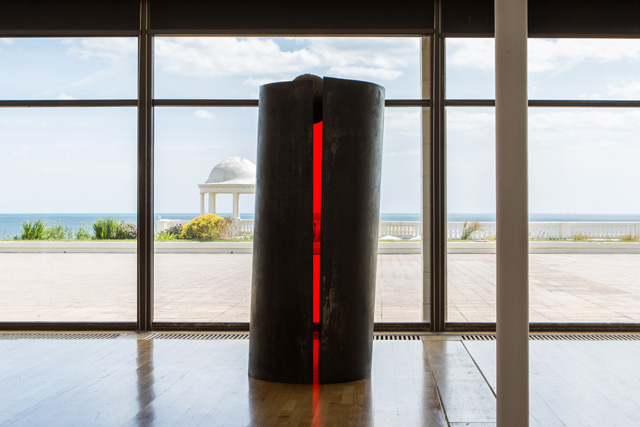
Alison Wilding. Red Skies, 1992. Patinated steel, acrylic, brass, bronze wire, brass, and wire. Courtesy of the artist and Karsten Schubert Gallery, London.
Hatty Nestor: Alison, I am interested in the concept between your solo show, Right Here and Out There, and the materiality of your work and the relationship to the landscape outside the gallery?
Alison Wilding: It’s a very unusual gallery space, and isn’t particularly beautiful. But it has these windows that overlook the sea and horizon, which make it unique. When you go into a gallery like that, all you really want to do is look out of the window, so the challenge for the artist is to get the viewer to turn their back on the view to the artwork; it is a fantastic backdrop for the artwork – in terms of visitor experience, it is unprecedented.
HN: I am interested as to how artists bridge the gap between the nature/human-centric binary and ideas about ecology. Did your show intentionally explore environmental issues?
AW: It is unusual for galleries to show that relationship: in most of them, you are in a sort of cocoon. There is a reaction against the white cube aesthetic, and I think the De La Warr does address that. Rosie and I tried to bridge that gap between the inside and the outside. The work on the roof, Riptide (2018), has a very distinct reaction to what’s around it and to the piece Docking (2018) in the flowerbed. The gallery itself made it very easy to do that.
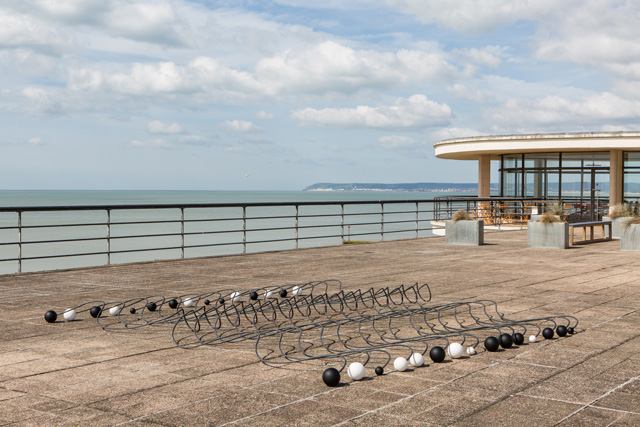
Alison Wilding. Riptide, 2018. Courtesy the artist and Karsten Schubert London. Photograph: Rob Harris.
HN: Time and space play a large role in your practice. The show is an archive of work from your career; for instance, Dark Horse is from 1983. Exhibiting all your work together, does it function as an archive of your past?
AW: I think that’s happened because there is a whole range of decades. The title of the show, Right Here and Out There, makes the connection between where you might be and what might be outside in a more celestial context – something that isn’t necessarily present and material. Just being in the world draws me to specific materials, and ways of combining them. For instance, I bought a roll of papyrus, which you can see in the work Angelpress (2007), in Egypt, but I don’t think any of the materials are unusual, or there is a hierarchy to them. Often the choice is determined by what's available to me.
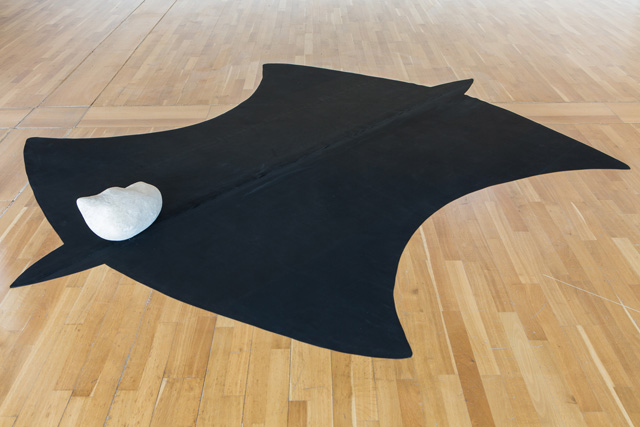
Alison Wilding. Dark Horse 1, 1983. Portland roach and neoprene. Courtesy of the artist and Karsten Schubert Gallery, London.
HN: Many of the works are black, and have a sense of melancholy about them, particularly in Drowned (1993) and Displace (1990). There’s a feeling of being uprooted in them – is this conscious? Do the titles of the works have much bearing on their content? Or do you like to leave this open for the viewer?
AW: I can be quite a melancholy person, and I see that in how some of the work can be perceived. The work Displaced reminds me of someone running down a street holding a TV. Like something completely wrong, like a massive TV set from the 1960s. Some of them seem entirely wrong now, but a title is just a hook, not a definition. It’s not a title of an essay; it’s just a name. Some of them are inappropriate, which is deliberate, and some of them offer a flavour for what the work is. I don’t want them to be too loaded.
HN: I think when many people attend an exhibition, they want to be told how to feel, how they should respond, or what the content of the work is. But perhaps that is quite reductive?
AW: Yes, I don’t want to do that.
Florence Peake: We were talking about backstories and this endless need to contextualise work, which many art institutions need to do. I am a believer in the imagination of the viewer and the death of the author. The person viewing should be allowed to have their own imaginative experience. If you are given this whole description before arriving, it has a very loaded agenda. How does the work live on in the imagination? It’s essential for an artist to let go of managing and controlling the art. There’s this offensive term in institutions now called “audience experience”.
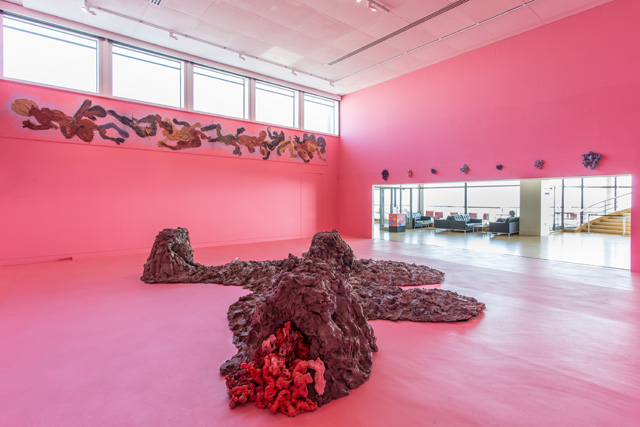
Florence Peake. RITE: On this pliant body we slip our WOW! 2018. Photograph: Rob Harris. Image courtesy De La Warr Pavilion.
AW: It also makes it very easy for the institution to create that kind of narrative about the art and the artist. It’s comfortable, in a box and comprehensible – I don’t think Florence or I do that. It’s quite individualistic, and, by not giving a description, the work can be more collaborative and free, as opposed to a predetermined set of ideas.
HN: Performance raises the question: how does the work exist beyond the live event? How does it survive afterwards? For instance, in your performance, Florence, the clay exists after the dance.
FP: I am always wrestling with this idea of the ephemeral act in performance and what the remnant is of it. I like the idea of the object that is left having its own life and autonomy as opposed to being solely linked to the event, like a trace. It stays active in a way, but it isn’t romantically enslaved to one moment that happened. It can become quite restrictive when you focus on the live event.
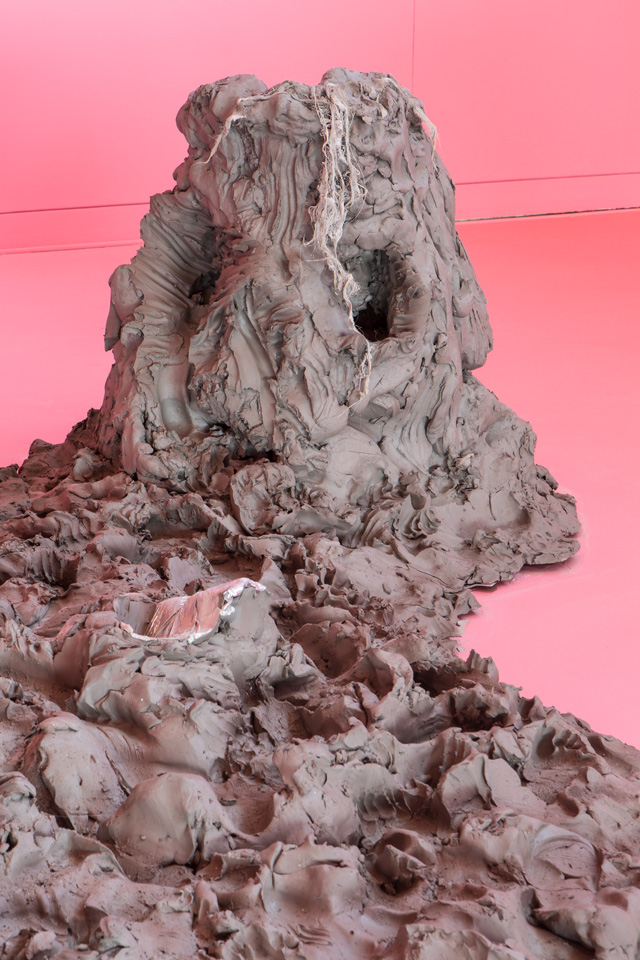
Florence Peake. RITE: On this pliant body we slip our WOW! 2018. Photograph: Rob Harris. Image courtesy De La Warr Pavilion.
HN: Which is true to performance and focusing on the present. As someone who makes performance work, do you feel people are usually only interested in the live performance?
FP: Different performances have different kinds of outcomes. I would say live bodies sometimes activate a space.
HN: How did you come to look at the Rite of Spring and ballet specifically?
FP: My training is in dance. The Rite of Spring is an iconic work that hands over modernist dance techniques. Even though it was ballet roots that made that work initially, it was very radical in its method of choreography. None of the dancers wore ballet shoes; instead of the dancers’ feet turning out they turned them in, and also never elevated en pointe. Instead of there being a very strict narrative, there were themes. The music was polyrhythmic and was so radical that there were riots when it was performed. I have a particular dislike for ballet; ethically, it is very problematic.
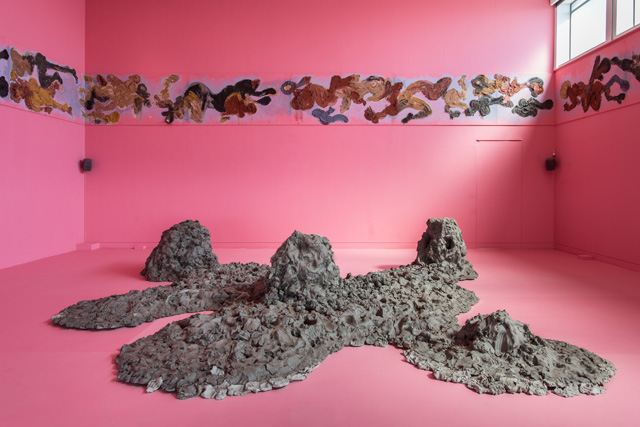
Florence Peake. RITE: On this pliant body we slip our WOW! 2018. Photograph: Rob Harris. Image courtesy De La Warr Pavilion.
HN: Did you want to look at the application of gender in this work and deconstruct it?
FP: It is a very heteronormative space, which contributed to enormous amounts of misogyny. It is a monument of modernist history, along with James Joyce’s Ulysses and those vast moments that deconstructed so much culturally, setting a new precedent. Engaging in that history was fascinating. I was also interested in looking at fascism historically, especially concerning what was going on politically in 1913 and the relationship to the political present. Ballet has a very fascistic relationship to the body, I think – the visceral instinctive body and ideas of the primal.
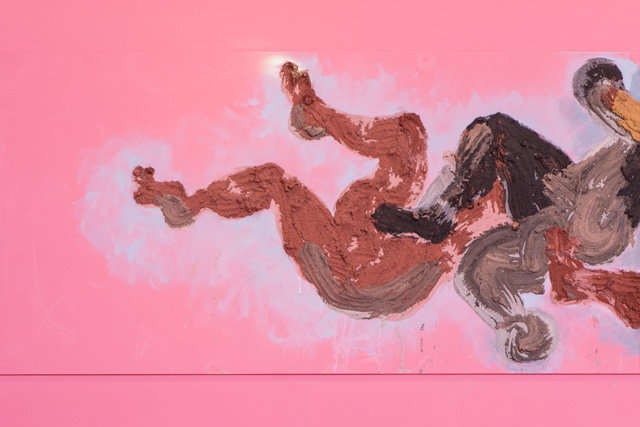
Florence Peake. RITE: On this pliant body we slip our WOW! 2018. Photograph: Rob Harris. Image courtesy De La Warr Pavilion.
HN: I suppose many reactions to the political present are quite visceral and cathartic. How do we deal with rage in society? Your work seems very brave in its physical dealings with the emotional effects of politics. Can dance be a form of protest?
FP: I think at this moment it can. There are a lot of very remarkable performers now – Jamila Johnson-Small, for example. There are a lot of people using the medium of dance politically. Dance has always been the poor cousin to a lot of art forms, particularly British dance … it’s very heteronormative with cute girls in dresses and men in suits.
HN: Perhaps dance, like writing, allows for immediacy in creating. Alison, do you feel the materials you use affect how quickly you can produce something?
AW: The way I work is just action, it becomes a chain reaction. It’s never about waiting for materials, I don’t think. It’s so long since I’ve made a piece of work personally that I can’t remember how it goes! I don’t think it relies on inspiration.
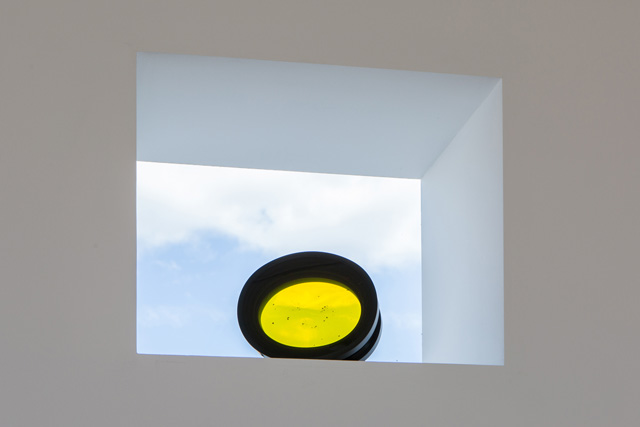
Alison Wilding. Floodlight, 2001. Cast acrylic. Courtesy of
the artist and Karsten Schubert Gallery, London.
HN: I suppose part of it is to do with permission. Who might be given visibility and space? Alison, did you find this was true regarding gender while you were studying at the Royal College of Art?
AW: There were only three women in the whole school when I went there [1970-73]. It was very male-dominated. I loved it, I just felt like one of the boys. I wasn’t a feminist in those days; I don’t think I knew the meaning of the word, I’m sorry to say. It was a very misogynistic place and amazingly undermining. I went from doing my degree at Ravensbourne, where it was half men, half women to the Royal College of Art, which was so slanted against women, it was quite a shock.
FP: In dance, many of the positions of power are held by men, yet 90% of people involved are women. That’s a massive shift, from three women to the current climate of art schools.
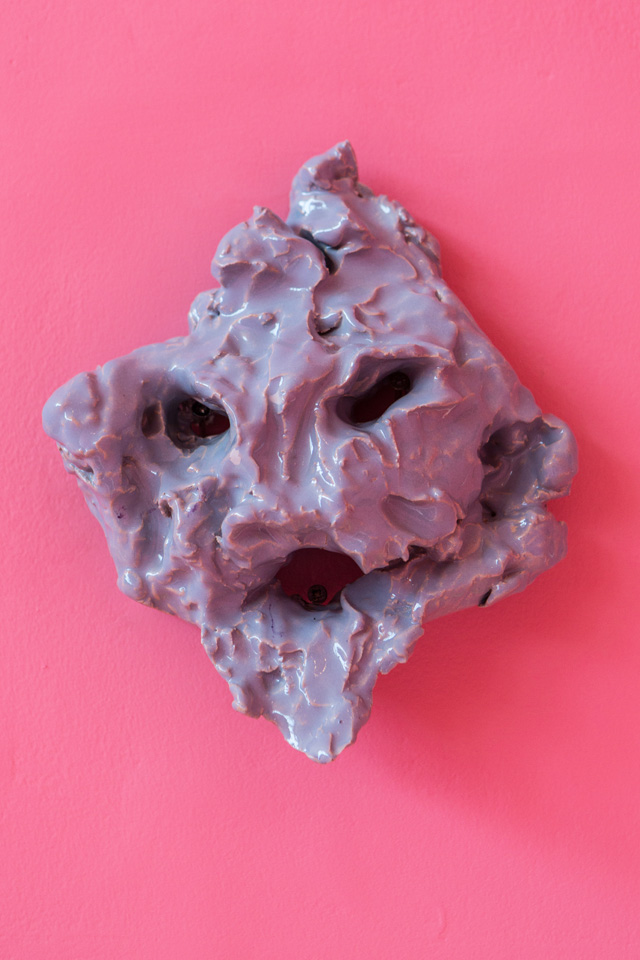
Florence Peake. RITE: On this pliant body we slip our WOW! 2018. Photograph: Rob Harris. Image courtesy De La Warr Pavilion.
HN: Do these experiences inform the exhibition?
AW: I hope that with the work I’ve got in the show, the experience that you could have with it is so different from the daily experience of things thrown continuously at us societally – on your phone, hyper-information, there’s so much fast stuff going on. The show is just about stopping and being able to do nothing. It’s an alternative to whatever; I don’t think art is going to change anyone’s life, not in the way film can do.
FP: Is that because you work in a particular medium?
AW: It’s about something else, imagination and different ways of experiencing the world. I don’t want to make too many claims about what I do or don’t do. I never made claims that my work is political or changing the world.
FP: I don’t want to make claims either: it’s a difficult thing to put on the viewer. I do think there is something about being in one’s medium, where I see a dance piece, and I feel very affected by it. I’m quite interested in the idea of kinesthetic empathy – when you watch someone moving, there is a part of your brain that moves with it: it’s physiological. I don’t want to make claims about the work, but I do sometimes wonder if the viewer experiences the work in a kinesthetic way.
HN: Do you see this capacity to empathise as political?
FP: I think everything is political, but it’s still I think it’s very arrogant to demand a specific reaction in the viewer. Saying that, I am quite demanding of the viewer, in that there are certain things I want to have as a performer, which is entirely selfish.
AW: I don’t think it is selfish. I create work for myself, not for other people. The only demand I place on the work is if I’ve had a visceral response to it, and I would hope that other people get that when they view it. It’s being affected and moved by something. It’s a hope for the art, which it will transfer.
FP: I want that kinesthetic response; the physical process is incredibly alive for me, too.
• Florence Peake: RITE: On This Pliant Body We Slip Our WOW! is at the De La Warr Pavilion, Bexhill, until 2 September 2018; Alison Wilding: Right Here and Out There is at the same venue until 16 September 2018.